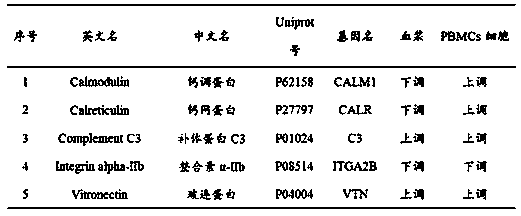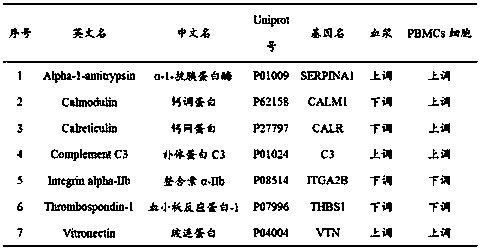Diagnostic marker and equipment for detecting autism spectrum disorders, and application
A diagnostic marker and technology for autism, applied in the field of diagnostic markers for detection of autism spectrum disorders, can solve the problem of no specific therapeutic drugs or specific biodiagnostic markers for detection of autism spectrum disorders, and achieve enhanced objectivity Effect
- Summary
- Abstract
- Description
- Claims
- Application Information
AI Technical Summary
Problems solved by technology
Method used
Image
Examples
Embodiment 1
[0021] Seven differential proteins that were simultaneously changed in the plasma and peripheral blood mononuclear cells of ASD children 1 and healthy controls were obtained, as shown in Table 1 below. Among them, five proteins have the same expression trend in the two, that is, α-1-antitrypsin, complement protein C3, and vitronectin are all up-regulated in plasma and PBMCs cells; integrin α-IIb, thrombospondin-1 It was down-regulated in both plasma and PBMCs cells. The expression trends of the two proteins were opposite, that is, calmodulin and calreticulin were down-regulated in plasma, but up-regulated in PBMCs.
[0022] surface ASD children 1 and control plasma and peripheral blood mononuclear cells co-change differential proteins
[0023]
Embodiment 2
[0025] Three differential proteins that were simultaneously changed in the plasma and peripheral blood mononuclear cells of ASD children 2 and healthy controls were obtained, as shown in Table 2 below. Among them, one protein: α-1-antitrypsin was up-regulated in both plasma and PBMCs cells, and the expression trend was consistent in both; two proteins: calmodulin and calreticulin were down-regulated in plasma, and were down-regulated in plasma. It was up-regulated in PBMCs cells, and the expression trend was opposite in both.
[0026] Table 2 Differential proteins in ASD children 2 and control plasma and peripheral blood mononuclear cells
[0027]
Embodiment 3
[0029] Obtain 5 differential proteins that change simultaneously in plasma and peripheral blood mononuclear cells of ASD children 3 and healthy controls, as shown in Table 3 below. Three of them had the same expression trend in the two, namely: complement protein C3 and vitronectin were up-regulated in both plasma and PBMCs; integrin α-IIb was down-regulated in both plasma and PBMCs. The expression trends of the two proteins were opposite, that is, calmodulin and calreticulin were down-regulated in plasma, but up-regulated in PBMCs.
[0030] Table 3 Differential proteins in ASD children 3 and control plasma and peripheral blood mononuclear cells
[0031]
PUM
 Login to View More
Login to View More Abstract
Description
Claims
Application Information
 Login to View More
Login to View More - R&D
- Intellectual Property
- Life Sciences
- Materials
- Tech Scout
- Unparalleled Data Quality
- Higher Quality Content
- 60% Fewer Hallucinations
Browse by: Latest US Patents, China's latest patents, Technical Efficacy Thesaurus, Application Domain, Technology Topic, Popular Technical Reports.
© 2025 PatSnap. All rights reserved.Legal|Privacy policy|Modern Slavery Act Transparency Statement|Sitemap|About US| Contact US: help@patsnap.com



